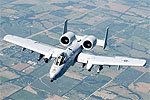Air Force general: We've flown the wings off the A-10
 ORLANDO, Fla. — Despite its venerable service to the Air Force, the A-10 is nearing the end of its lifespan, a top general said Thursday.
ORLANDO, Fla. — Despite its venerable service to the Air Force, the A-10 is nearing the end of its lifespan, a top general said Thursday.
“We have literally flown the wings off it,” said Maj. Gen. Thomas Deale, the director of operations for Air Combat Command and a former A-10 pilot.
The Air Force has made several attempts to retire the plane and shift its resources and maintenance crews over to the fifth-gen F-35 — efforts that have repeatedly been shot down by Congress.
The service’s budget proposal for fiscal year 2017 relented, and included plans to keep the Warthog in service until 2022.
Speaking at the Air Force Association Air Warfare Symposium in Orlando, Florida, Deale warned that the aircraft is starting to show its age.
“As exceptional as it is, it is one day going to have to come out of the inventory basically from the system’s age, the stresses we’ve been putting on it, our ability to continually maintain it, and the costs associated with it because of operations are going to increase,” he said. “Likewise, when you look at the contested and highly contested environments, it’s not one the A-10 was designed for. It’s not one it’s going to have access to.”
The A-10’s replacement, the F-35 Lightning II, is going to be “incredible” at close air support missions, the general said.
“It’s not going to do it the same way the A-10 does,” Deale said, adding that the ability of the F-35 to integrate information from hundreds of places in real time — including receiving data from troops on the ground — is a huge advantage it has over the older craft.
Plus, the F-35 will serve as a multi-role aircraft, he said. On Day One of a conflict, the F-35 can go full stealth to take out select enemy air defense sites. By Day Five or Six, it can load up additional missiles and external munitions, lessening its stealth profile but increasing the number and types of targets it can destroy on the ground.
“That’s what the A-10 can’t do,” Deale said. “As we’re going towards recapitalization of the force, with a smaller force, we’ve got to make sure we can get the biggest bang out of our buck. It’s going to drive us towards a mutli-mission solution. The days of having the luxury of unique specialized capabilities are fleeting.”
Representatives from the Army and Marine Corps who were on the panel said that they are largely “agnostic” when it came to which aircraft the Air Force is using for close air support missions.
“As long as it’s overhead and it’s dropping where we want it to drop, we could care less what plane it is,” said Marine Col. David Bradney.
The Air Force is currently standing up a Close Air Support Integration Group to look at how the A-10 supports the mission and how that expertise can be passed onto the future, Deale said.
“Close air support’s a mission set,” he said. “It’s a mission set we did before we ever conceived the A-10. It’s a mission set we’re going to do 50 years from now when none of the aircraft currently in the inventory are flying.”